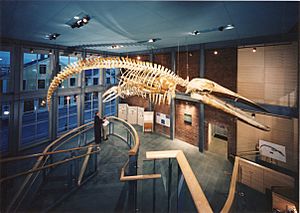KOBO (whale) facts for kids

KOBO (which stands for King of the Blue Ocean) is the skeleton of a young blue whale. It is about 66 feet (20 meters) long. You can see it on display at the New Bedford Whaling Museum in New Bedford, Massachusetts.
This whale was sadly hit and killed by a large tanker ship. It was found near Rhode Island in March 1998. A sixth-grade student named Katie Hallett from New Bedford chose the name KOBO for the skeleton. It was put on display in the year 2000. KOBO shares its gallery with three other whale skeletons. These include a 37-foot (11-meter) male humpback, a 49-foot (15-meter) female North Atlantic right whale who was pregnant, and her unborn calf.
Contents
How KOBO Was Found
KOBO was discovered on March 3, 1998. The crew of a pilot boat in Narragansett Bay, Rhode Island, saw a dead whale. It was caught on the front, or bulbous bow, of a 486-foot (148-meter) tanker called Botany Triumph. The ship's crew didn't seem to know they had hit a whale. The tanker had to back up to get the whale off its bow.
A few days later, scientists identified the whale. It was a young male blue whale, likely between 4 and 6 years old. This was a very rare discovery. There are only about 500 blue whales in the North Atlantic. Also, a blue whale had not been found stranded on the East Coast since 1891.
What Scientists Learned About KOBO
After the whale was identified, the Coast Guard towed its body. They brought it to Second Beach near Sachuest Point National Wildlife Refuge in Middletown, Rhode Island. There, scientists performed a necropsy. This is like an autopsy for animals, where they examine the body to find out why it died.
Parts of the whale were given to science groups around the world. These parts helped with research on things like genetics, how toxins affect whales, and their vision, hearing, and breathing. The necropsy showed that the whale had a broken jaw and a deep cut on its jaw. It also had bruises around its middle. However, it was quite healthy before these injuries.
Researchers believe the whale was first hit by a propeller, possibly from a different ship. Then, it was killed when the Botany Triumph crashed into it. No one knows the exact place or date of its death. But it's thought the whale was hit off the coast of Nova Scotia around March 1, 1998. It then got stuck on the ship's bow until it was found days later in Narragansett Bay.
Getting KOBO Ready for Display
After the necropsy, the National Marine Fisheries Service gave the whale to the New Bedford Whaling Museum. The museum agreed to show the full skeleton to the public for free.
First, the whale's body was taken to the New Bedford landfill. Volunteers and scientists carefully removed the flesh from the bones. Then, parts of the body were put into 22 special cages. These cages were placed in New Bedford harbor for five months. This allowed sea creatures to naturally clean the bones.
Finally, the bones were brought to the museum courtyard to dry and bleach in the sun. The skull and lower jaw alone were 18 feet (5.5 meters) long and weighed 1.5 tons! They needed a special shelter and workshop. Scientists also found that some of the backbone bones (vertebrae) were badly damaged from the collision. The museum borrowed sample vertebrae from Harvard University. They made fiberglass copies that were painted to look like the real bones.
Blue whale bones are very oily. While the skeleton was being prepared, the oil made the bones turn yellow and smell bad. To fix this, the bones were soaked in a special solution used for leather. Even years after the whale's death, the skeleton still leaks oil. The museum has tubes set up to collect this oil. It goes into a beaker where visitors can see it and learn about whale oil.
How KOBO Got Its Name
In 2000, the New Bedford Whaling Museum held a contest. Children were asked to write essays to name the skeleton. The museum received about 1,200 entries! The winner was Katie Hallett, a sixth-grader from New Bedford. She chose the name KOBO, which stands for King of the Blue Ocean. The name was announced on June 5, 2000.
Where You Can See KOBO
In July 2000, KOBO was put on display. You can find it in the Jacobs Family Gallery, which is the entrance gallery of the New Bedford Whaling Museum.
KOBO shares this space with three other whale skeletons:
- A 37-foot (11-meter) male humpback named Quasimodo.
- A 49-foot (15-meter) female North Atlantic right whale named Reyna. She was 10 months pregnant when she died.
- Reyna's unborn female calf.
The museum uses these skeletons to teach visitors about whale conservation. This means protecting whales and their homes. They also teach about the history of whaling in the United States.

